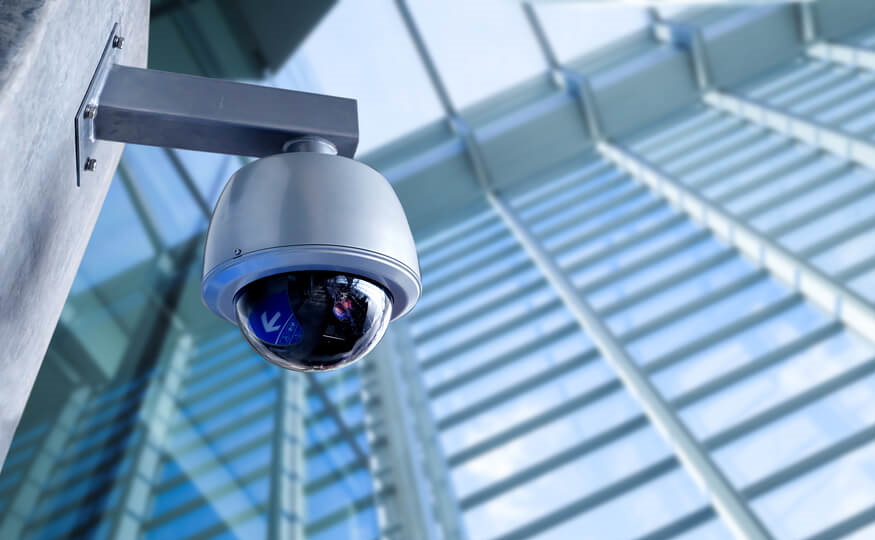Guide To Choosing A Security Camera System
When considering a security camera system, you need to decide:
- What is the purpose of the system and what do I reasonably expect from it?
- Do I want only live video or do I want to record?
- Do I want to set up a local recorder, or record to the ‘cloud’?
- Will I use coax, siamese (coax/power) or network cable (CAT5/CAT5e/CAT6)
- Or is a wireless / WIFI camera a better choice (the only choice?)
- Where will I place the cameras and what view do I need?
- Budget
If you wish to simply watch live video, you can use an analog CCTV system that can connect to a TV style monitor. Or you can use an IP network camera that uses CAT5/CAT6 cable connected to your home/business network and then use a PC to watch the video.
Most people would like to record security video. In this case your choice is to either record it on the camera itself if it has an SD card slot, or to a recorder on site called a DVR or NVR, or to record to ‘the cloud’ using an Internet connection.
Local recording on the camera would be good for a spy camera recorder for example and is often an option for IP network cameras. Of course if the camera is within reach it may be stolen and the video goes with it in this case.
Recording to ‘the cloud’ is an option typically for only 1-3 cameras and based on motion only. It will require a high speed Internet connection with the most important considerating being the UPLOAD speed. Wired network cameras may be used here, or a WIFI camera can be used if it’s too hard to run wires. With few exceptions, the camera will still require a power wire regardless. The Ring Stick Up Cam is one system that can run on a rechargeable battery and connect via WIFI, using cloud recording (and with a monthly fee). Foscam also offers cloud recording for most of its wired and WIFI cameras.
In most cases where more than one camera is involved, local recording on site to a camera recorder is the most practical method because it doesn’t require any monthly fees, has much more video storage (recording to a 1TB or larger hard drive), and doesn’t require super fast Internet upload speed. Even a high speed DSL or cable connection is not up to recording ful ltime video from high definition cameras full time.
For a system with a local recorder, the camera(s) will either be WIFI connected, or more often they will be connected by either a coax cable (similar to TV cable), siamese cable (coax and power together), or using a CAT5e or CAT6 network cable(s).
If the system is an upgrade from an older CCTV camera system, most likely coax cable was run and in that case HDCVI, HDTVI and AHD systems can provide high definition video over the same coax cable that’s already in place. These systems also tend to be lower cost compared to network camera systems.
For new installations, CAT5e/CAT6 network cable is often the best choice because the cable is less expensive, physically thinner, and when used with the right cameras, can provide both video and camera power over the same cable. For smaller systems up to 16 cameras we will often recommend an NVR (network video recorder) that has built in camera ports. The network cable from each camera goes back to this NVR for power and video. Then the NVR can connect to your local network for remote access if needed. Older IP network camera systems were difficult to configure. Most newer systems automatically configure the cameras when connected to the NVR, making them a snap to set up. Network cameras will generally provide the best upgrade path because they can support cameras right up to 4K resolution on the same wire.
Once you’ve decided on the camera technology (CCTV, HDCVI, HDTVI, HSDI, AHD, IP network, WIFI) there are a few more camera features and styles to take in to consideration. If you haven’t chosen the camera technology yet, check out our security camera technology guide for more information.
Camera Style or Form Factor
Choosing a camera form factor or style, is a combination of personal preference and application.
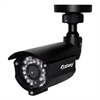 Bullet Cameras, also known as barrel cameras are very versatile and tend to be a good choice for outdoor use. They tend to have a sun shield that protects the camera lens from direct exposure to the sun at it’s low points during the day, and this shield also helps keep rain and snow from getting on the glass covering the camera lens. These cameras tend to be wall mounted and the wiring will either be exposed or sometimes will route through the camera bracket.
Bullet Cameras, also known as barrel cameras are very versatile and tend to be a good choice for outdoor use. They tend to have a sun shield that protects the camera lens from direct exposure to the sun at it’s low points during the day, and this shield also helps keep rain and snow from getting on the glass covering the camera lens. These cameras tend to be wall mounted and the wiring will either be exposed or sometimes will route through the camera bracket.
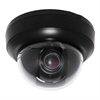 Dome cameras are more vandal resistant by nature of their dome cover and can be a little less obtrusive as they tend to have a smaller low profile design. They can be wall or ceiling mounted, or mounted under a soffit. They may be mounted directly to a wall or a wall mount bracket may be used in case the camera needs to point down on a sharp angle, and to help keep the elements off the lens area of the dome. Dome cameras are available for both indoor and outdoor use. There are traditional dome cameras as well as variations that may be called snail shell or eyeball dome, as well as turret domes that look almost like a barrel pointing out of the dome frame.
Dome cameras are more vandal resistant by nature of their dome cover and can be a little less obtrusive as they tend to have a smaller low profile design. They can be wall or ceiling mounted, or mounted under a soffit. They may be mounted directly to a wall or a wall mount bracket may be used in case the camera needs to point down on a sharp angle, and to help keep the elements off the lens area of the dome. Dome cameras are available for both indoor and outdoor use. There are traditional dome cameras as well as variations that may be called snail shell or eyeball dome, as well as turret domes that look almost like a barrel pointing out of the dome frame.
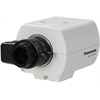 Box cameras were the original standard and may be favoured by some installers as they are often sold without a lens, so the installer can choose a lens that meets the application. They are often seen indoors where vandal resistance isn’t a concern, but they can also be used outdoors if they are mounted inside a weatherproof enclosure.
Box cameras were the original standard and may be favoured by some installers as they are often sold without a lens, so the installer can choose a lens that meets the application. They are often seen indoors where vandal resistance isn’t a concern, but they can also be used outdoors if they are mounted inside a weatherproof enclosure.
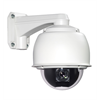 Pan/Tilt or Pan/Tilt/Zoom (PTZ) cameras are a variation on the dome style but rather than being mounted and aimed in a fixed direction, they can be remotely controlled. They can pan, tilt, and sometimes feature a remote controllable zoom lens so the operator can move the camera around to follow a subject or get zoom in for better detail. Generally pan/tilt cameras are manually controlled by an operator either on site or remotely situated. But some PTZ cameras feature auto-tracking so the camera can stay zoomed out looking at an overview of the area, until something moves, at which time they will zoom in and/or follow the subject. Care should be taken here because multiple ‘targets’ are a problem with auto-tracking cameras at times, and they are more rare and more expensive.
Pan/Tilt or Pan/Tilt/Zoom (PTZ) cameras are a variation on the dome style but rather than being mounted and aimed in a fixed direction, they can be remotely controlled. They can pan, tilt, and sometimes feature a remote controllable zoom lens so the operator can move the camera around to follow a subject or get zoom in for better detail. Generally pan/tilt cameras are manually controlled by an operator either on site or remotely situated. But some PTZ cameras feature auto-tracking so the camera can stay zoomed out looking at an overview of the area, until something moves, at which time they will zoom in and/or follow the subject. Care should be taken here because multiple ‘targets’ are a problem with auto-tracking cameras at times, and they are more rare and more expensive.
Camera Lenses
Cameras see the world through a lens. Most often the lens is fixed with common sizes being 2.8mm, 3.6mm, 4mm, 6mm, 8mm and 12mm. The higher the number, the closer the subject will appear to the camera. In other words it is more ‘zoomed in’ on the subject. At the same time, as the camera is looking at a more zoomed in image, it is seeing less of the viewing area just like with a point and shoot camera or smart phone camera. In other words, the viewing area is smaller.
Security cameras may also have varifocal lenses. Varifocal lenses are normally manually adjusted by the installer so that just the right viewing area and/or zoom is achieved. Varifocal lenses are typically expressed as their low and high range. For example you may see 2.8~12mm or 4~9mm or in some higher end lenses you may see something like 3.3~22mm. The lens will typically have two adjustments, one to move between the low and high zoom, and the second to focus the image. Some cameras may feature remotely controlled motorized varifocal lenses with automatic focus. This is typically found on high end IP network cameras with price points to match, with the benefit being that the installer can mount and aim the camera, then get off the ladder and sit down while remotely zooming to the needed shot.
Viewing Angle and Viewing Area
When selecting a security camera, some thought has to be made as to the area to be covered. Are you looking to cover a small room, or the area close to the camera by a door perhaps? Or do you need to watch over a larger area, or possibly get a view of the end of a 50 foot driveway?
Each camera will have a viewing angle and a horizontal viewing area that dictates what sort of area you can expect to capture and these two features are closely tied to each other. The wider the viewing angle, the more horizontal viewing area will be covered at a given distance. For example a camera with a 45 degree viewing angle will capture a narrow horizontal viewing area when compared to one with a 70 degree viewing angle. As the subject gets further from the camera, the viewing area increases. In other words at 10 feet from the camera, the horizontal view may be 20 feet across but at 50 feet from the camera it is much wider. The larger the viewing angle or area covered, the less detail can be expected to be available in the video captured because given a fixed resolution or number of dots making up an image, those dots will be more spread out as the viewing angle increases. At the same time, the further the subject is from the camera, the harder it will be to see smaller details.
So don’t expect to cover a wide area and then be able to recognize a person 100 feet away. Don’t expect to cover a big outdoor area and be able to make out a license plate. License plate cameras are typically meant to be aimed at an area not much wider than a vehicle for best recognition. Generally speaking you will want to choose a camera that offers a view no wider than you really need. Sometimes you may choose a camera that covers a wide area but then you may want a second camera zoomed in to capture a plate or person’s face up close.
Witth the advent of higher resolution, megapixel cameras, we can now cover a larger area and still see great detail. Or we can get much more detail from the same smaller viewing area. But the real world doesn’t work like what we see on TV and generally what you see is what you get. You can’t go back and visually blow up and enhance something that is unrecognizable in the original footage. But it looks cool on TV. So think about what you wish to achieve and choose he coverage accordingly.
Lighting, Back Lighting, Headlights and Night Vision
Lighting plays a part in camera selection. For example, if you plan to use a camera indoors with the lights always on, pretty much any camera will do the job. However if you plan to aim an inside camera towards a door that opens to the outside or an outside window, more care is needed. In this case, the light coming in from behind the subject is much brighter than the ambient lighting and will create an image where the subject looks like a shadow with features that can’t be seen. So either aim the camera away from these bright ‘back light’ situations, or make sure you get a camera with Wide Dynamic Range or WDR. Wide Dynamic Range cameras have a much wider range of dark to light coverage and so they can take in the bright back light while still letting you see the subject. Digital WDR cameras are good at this, while true or enhanced WDR cameras are even better.
This also comes in to play with car headlights. In this case the headlights at night will blind the camera so it can’t see the car let alone a plate. Look for WDR combined with a feature called HLC that is specifically meant to automatically black out or reduce headlight glare.
Taking images in the dark is also a challenge. If you have ever tried to take a picture when it’s darker or at night, your camera typically turns on the flash. In the case of security cameras, there is no flash but they either offer low light viewing in case where this is outside or street lighting available, or they will have night vision sensitivity or night vision infrared LEDs built in.
Low light cameras can see in lower light as the name implies but the more light sensitive they are at night, and the darker it gets, the picture will start to look more and more grainy. Newer cameras are surprisingly good at this however. But for true pitch black or dark performance, alternate illumination is required and typically that comes in the form of night vision LEDs. These infrared LEDs produce light that is invisible to the naked eye. In fact if you look right at most night vision LEDs they glow red but you won’t see a beam of light shooting out of them. Night vision LEDs cannot be used through glass so don’t expect to point the camera through a window – the beam will bounce back off the window and at best won’t do any good, or at worst will blind the camera.
There are completely invisible night vision LEDs available, that operate above 940nm and will not show any glow even when you look directly at them, but typically they are standalone devices, not built in to cameras and they tend to be expensive.
If you are ready to start taking advantage of all the benefits a smart home can deliver, it’s time to call Cam Technology at +1 (647) 607-4173 for any security camera installation Toronto queries. You can request a free quote online, and we can see what we can do for you.

